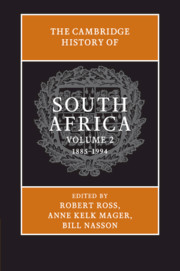Book contents
- Frontmatter
- Contents
- Contributors
- Acknowledgments
- Note on references
- Introduction
- 1 South Africa and South Africans: Nationality, Belonging, Citizenship
- 2 Imperialism, Settler Identities, and Colonial Capitalism: The Hundred-Year Origins of the 1899 South African War
- 3 Class, Culture, and Consciousness in South Africa, 1880–1899
- 4 War and Union, 1899–1910
- 5 South Africa: The Union Years, 1910–1948 – Political and Economic Foundations
- 6 South African Society and Culture, 1910–1948
- 7 The Apartheid Project, 1948–1970
- 8 Popular Responses to Apartheid: 1948–c. 1975
- 9 Resistance and Reform, 1973–1994
- 10 The Evolution of the South African Population in the Twentieth Century
- 11 The Economy and Poverty in the Twentieth Century
- 12 Modernity, Culture, and Nation
- 13 Environment, Heritage, Resistance, and Health: Newer Historiographical Directions
- Statistical Appendix
- Bibliography
- Index
- References
6 - South African Society and Culture, 1910–1948
Published online by Cambridge University Press: 28 July 2011
- Frontmatter
- Contents
- Contributors
- Acknowledgments
- Note on references
- Introduction
- 1 South Africa and South Africans: Nationality, Belonging, Citizenship
- 2 Imperialism, Settler Identities, and Colonial Capitalism: The Hundred-Year Origins of the 1899 South African War
- 3 Class, Culture, and Consciousness in South Africa, 1880–1899
- 4 War and Union, 1899–1910
- 5 South Africa: The Union Years, 1910–1948 – Political and Economic Foundations
- 6 South African Society and Culture, 1910–1948
- 7 The Apartheid Project, 1948–1970
- 8 Popular Responses to Apartheid: 1948–c. 1975
- 9 Resistance and Reform, 1973–1994
- 10 The Evolution of the South African Population in the Twentieth Century
- 11 The Economy and Poverty in the Twentieth Century
- 12 Modernity, Culture, and Nation
- 13 Environment, Heritage, Resistance, and Health: Newer Historiographical Directions
- Statistical Appendix
- Bibliography
- Index
- References
Summary
The Act of Union of 1910 provided the keystone to the edifice of white supremacy. It consolidated efforts that had been under way through the period of reconstruction, and more particularly responsible government (1907–1910), to reestablish white colonial hegemony after the shocks it had sustained during the South African War by putting an end to debilitating interstate competition over railways, labour and a variety of other issues. It provided a basis on which this could be systematically extended through the policy of segregation. Union facilitated the prosecution of two complementary and closely related programmes – the upliftment of poor whites and the subjugation of Africans. These two themes – poor whites and poor blacks – are generally treated separately from each other and have their own segregated historiographies, yet they are intimately related and constantly refract off each other. An attempt is made in this chapter to discuss them together.
- Type
- Chapter
- Information
- The Cambridge History of South Africa , pp. 254 - 318Publisher: Cambridge University PressPrint publication year: 2011
References
- 4
- Cited by



